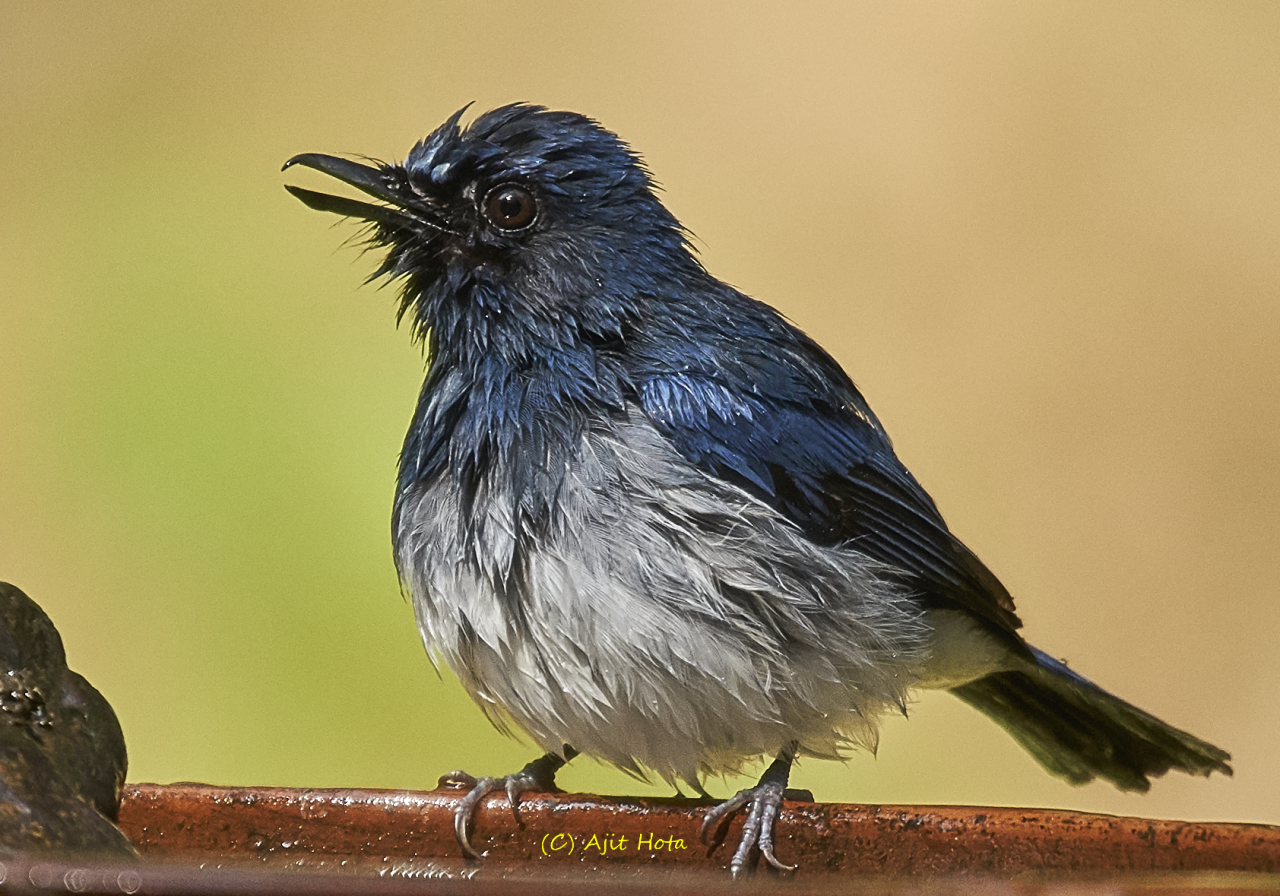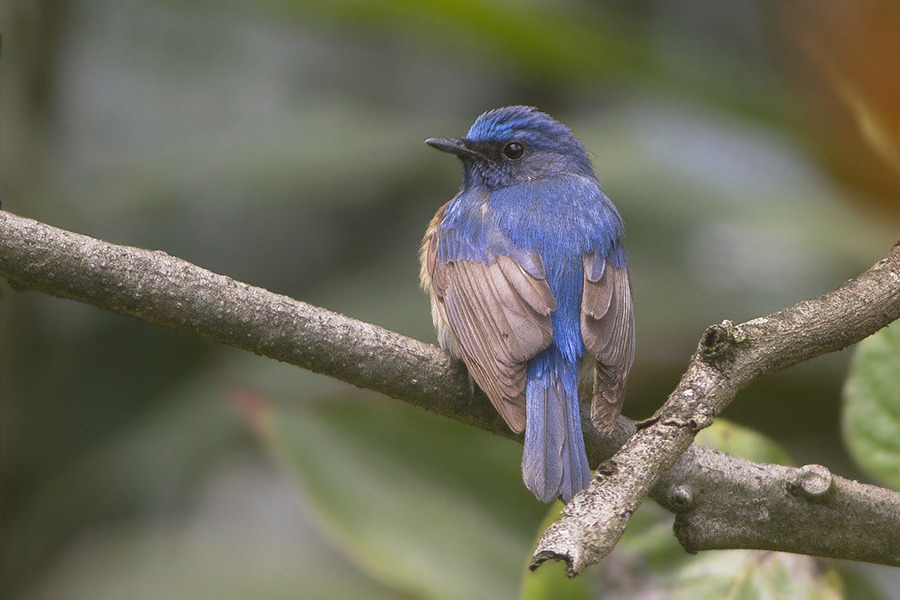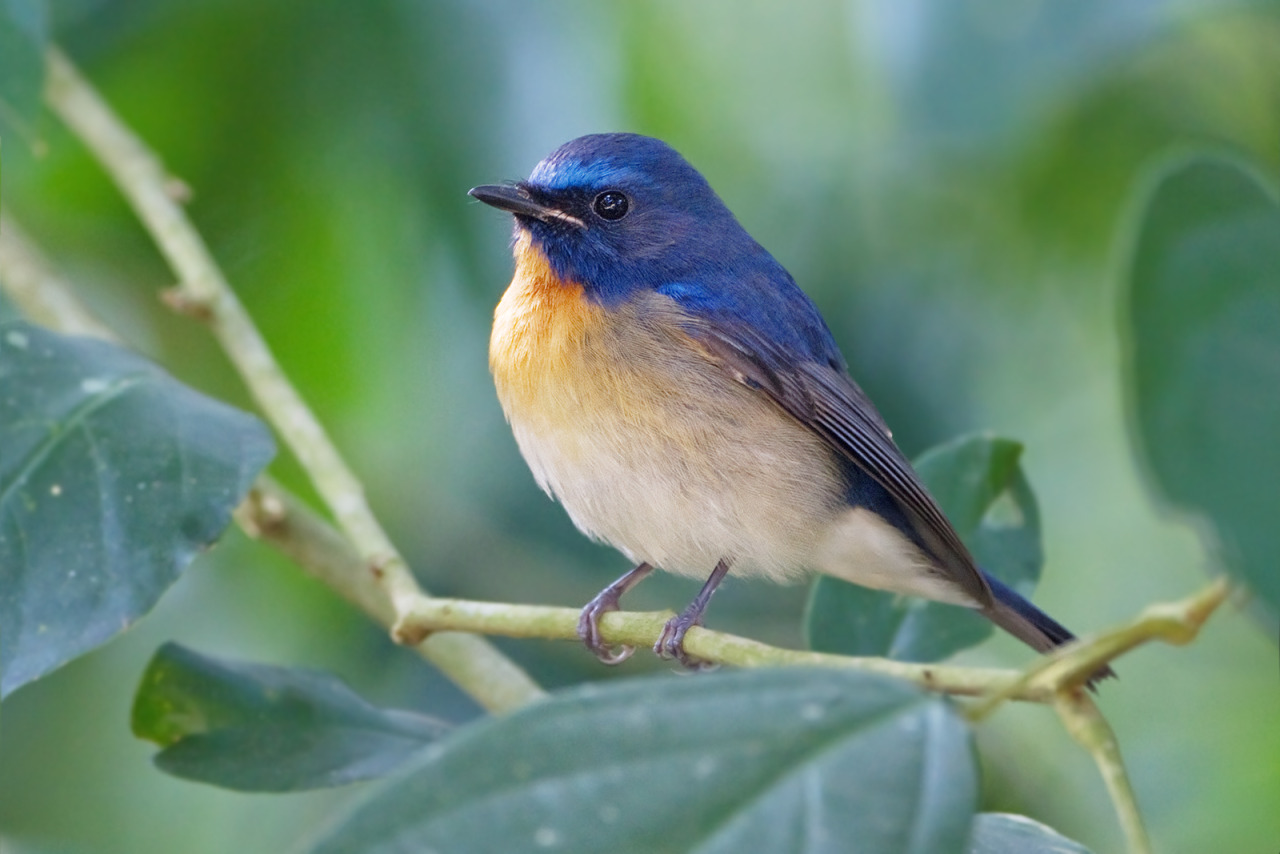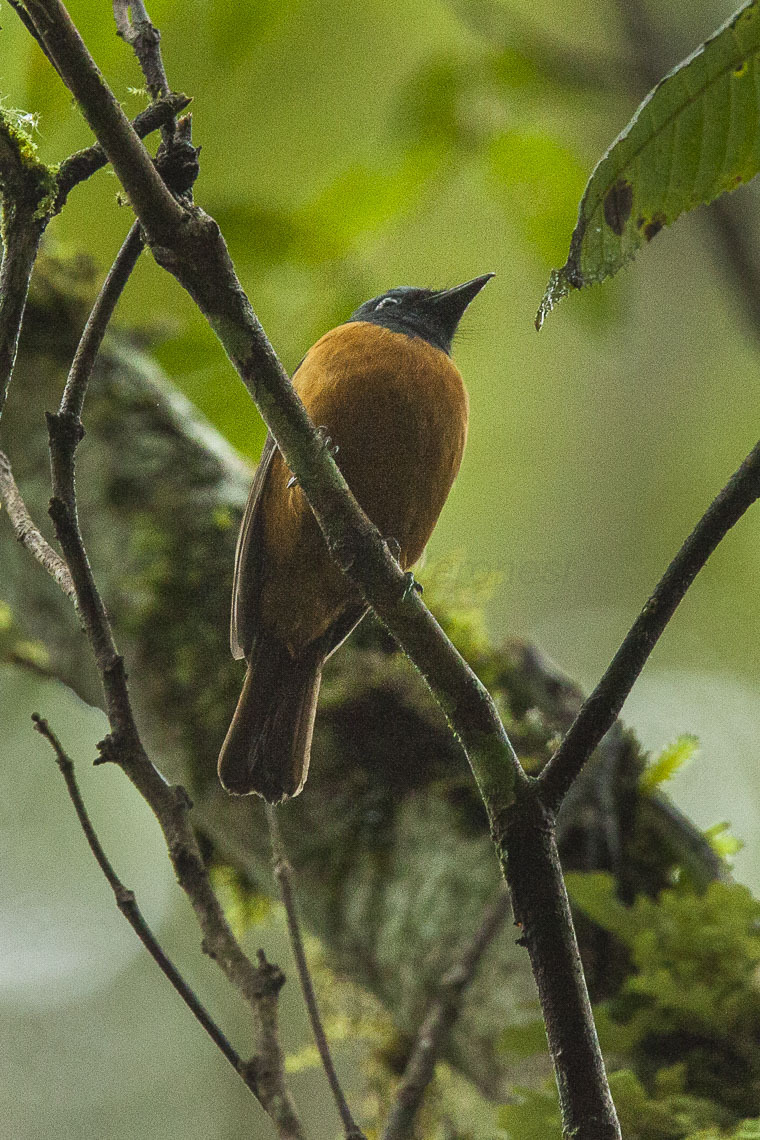Cyornis

Malaysian Blue Flycatcher by Bernard DuPont, CC BY-SA 2.0
Etymology: Dark-Blue Bird
Classification: Dinosauromorpha, Dinosauriformes, Dracohors, Dinosauria, Saurischia, Eusaurischia, Theropoda, Neotheropoda, Averostra, Tetanurae, Orionides, Avetheropoda, Coelurosauria, Tyrannoraptora, Maniraptoromorpha, Maniraptoriformes, Maniraptora, Pennaraptora, Paraves, Eumaniraptora, Averaptora, Avialae, Euavialae, Avebrevicauda, Pygostaylia, Ornithothoraces, Euornithes, Ornithuromorpha, Ornithurae, Neornithes, Neognathae, Neoaves, Inopinaves, Telluraves, Australaves, Eufalconimorphae, Psittacopasserae, Passeriformes, Eupasseres, Passeri, Euoscines, Passerides, Core Passerides, Muscicapida, Muscicapoidea, Muscicapidae
Referred Species: C. hainanus (Hainan Blue Flycatcher), C. unicolor (Pale Blue Flycatcher), C. ruckii (Rück’s Blue Flycatcher), C. herioti (Blue-Breasted Flycatcher), C. pallidipes (White-Bellied Blue Flycatcher), C. poliogenys (Pale-Chinned Blue Flycatcher), C. banyumas (Hill Blue Flycatcher), C. magnirostris (Large Blue Flycatcher), C. lemprieri (Palawan Blue Flycatcher), C. tickelliae (Tickell’s Blue Flycatcher), C. caerulatus (Sunda Blue Flycatcher), C. superbus (Bornean Blue Flycatcher), C. rubeculoides (Blue-Throated Blue Flycatcher), C. glaucicomans (Chinese Blue Flycatcher), C. turcosus (Malaysian Blue Flycatcher), C. rufigastra (Mangrove Blue Flycatcher), C. djampeanus (Tanahjampea Blue Flycatcher), C. omissus (Sulawesi Blue Flycatcher), C. hyacinthinus (Timor Blue Flycatcher), C. hoevelli (Blue-Fronted Blue Flycatcher), C. sanfordi (Matinan Blue Flycatcher), C. concretus (White-Tailed Flycatcher), C. oscillans (Russet-Backed Jungle Flycatcher), C. brunneatus (Brown-Chested Jungle Flycatcher), C. nicobaricus (Nicobar Jungle Flycatcher), C. olivaceus (Fulvous-Chested Jungle Flycatcher), C. umbratilis (Grey-Chested Jungle Flycatcher), C. ruficauda (Rufous-Tailed Jungle Flycatcher), C. colonus (Sula Jungle Flycatcher), C. pelingensis (Banggai Jungle Flycatcher)
Status: Extant, Critically Endangered - Least Concern
Time and Place: WIthin the last 10,000 years; in the Holocene epoch of the Quaternary period


Cyornis is known from the Indian subcontinent and southeast Asia, as well as islands of the Philippines and Indonesia within Oceania

Physical Description: The Blue Flycatchers are a group of small passerines, usually with some blue coloration in the males, though not always - and these males can be entirely blue, just blue on their backs and wings, or only have blue heads. The males can also have lighter blue stripes along their eyes. Some species also have blue females, which can be as brilliantly colored as the males or slightly duller in color. Most of the time, though, the females are brown in color. One or both sexes can be found with orange breast patches in some of the species; and some have entirely orange necks, breasts, and bellies. Some species have grey patches on their chests, heads, and backs, especially in the females. At least a few species are less brown than they are olive-greenish in color, or have grey patches on their faces. They range overall from 13 to 19 centimeters in length, but the vast majority of species are 15 centimeters long from beak to tail - in other words, about as long as the average pen or pencil. They usually weigh only around 20 grams. They have short, thin, and pointed beaks for catching their usual food source, insects. They also have small round heads and fairly large eyes for those heads. They have fairly short tails and round bodies
Diet: Cyornis primarily feeds on flies, as the name would suggest. However, most species do branch out into other small insects such as bees, ants, and aphids. Some species are known to eat beetles and other larger insects. Spiders and other, non-insect invertebrates are known to be fed upon by some species in this genus. At least one species has been documented eating a frog.

Pale Blue-Flycatcher by Francesco Veronesi, CC BY-SA 2.0
Behavior: Cyornis usually forages alone or in pairs, principally during the breeding season. At least a few species do feed together in large, mixed-species flocks in the tree canopy. However, the majority of these birds prefer a less crowded existence, and even will defend feeding territories during the non-breeding season. The level at which these birds feed depends on the species; most prefer the canopy of the trees, but some will be found in the undergrowth and midstory. Some also will forage on the ground. They do make aerial pursuits of food, and many species of Blue Flycatcher will chase after flies on the wing.
Cynornis varies in its movement patterns, with some species being entirely stationary, and others having extensive migration patterns in response to the flow of the rainy season. This is primarily based on home range habitat more than any other factor. Some species also migrate between elevations.
These birds make a wide variety of calls, usually trilling ones with a variety of ticks, tchuts, taks, titus, tsats, trrt, and other short shrill sounds. Some songs in some species are a little bit more distinctive, with at least two species having a call that vaguely sounds like “hello mummy”. Calls can vary within a species, as well, with intenser and weaker calls being switched between based on the situation at hand.

White-Bellied Blue Flycatcher by AjitK332, CC BY-SA 4.0
The Blue Flycatchers mainly breed between April and July, with some island species breeding as early as February to as late as September, depending on the species in question. For those whose breeding patterns are known, nests are primarily built out of twigs by the females and placed within the foliage and branches in a cup shape; males can help with nest building but primarily they aid in incubation of the eggs and guarding the nest. Clutches are usually two to three eggs, and juveniles of this genus are usually around by September and October; periods of incubation and fledgling are not well known. Though mating behavior is not well known, they seem to only form monogamous pairs for a specific breeding season, and do not remain together in the off-season, where they return to solitary habits.
Ecosystem: These birds live primarily in tropical wet and moist forests in Southeastern Asia and Oceania, at varying elevations and varying heights in the tree canopy, as well as varying places within the tree density of the forest. Many species live at the forest edge, others in the dense secondary growth portions of the jungle. At least a few species live in dry forests rather than wet ones, though the bulk of this genus are associated with more moist habitats. One species is unique in living entirely in coastal mangrove forests, associated with the entire coastline of the Philippines.

Hill Blue Flycatcher by J. J. Harrison, CC BY-SA 3.0
While their predators are not well known, at least a few species are subject to brood parasitism from cuckoos - so the cuckoo will lay their egg in the nest of the Cyornis.
Other: While most species of this genus are not threatened with extinction or only near threatened, at least a few are vulnerable to extinction. One species, the Rück’s Blue Flycatcher, is critically endangered due to an original small population size and limited habitat range, made worse due to habitat loss.
Species Differences: The variety of species primarily differ due to plumage variation and range, as well as specifics of the calls and habitat.

Hainan Blue Flycatcher by Rushenb, CC BY 2.0
The Hainan Blue-Flycatcher, C. hainanus, has brown females with orange breast patches; and dark blue males with light blue eye stripes. They live mainly in mixed deciduous forests in Southeast Asia.
The Pale Blue-Flycatcher, C. unicolor, has males that are lighter in blue color with sky blue chest patches; the females are brown and lack any orange chest plumage. They live mainly in moist lowland forests in Southeast Asia and Indonesia.
The Rück’s Blue Flycatcher, C. ruckii, has bright orange females and bright blue males; they live mainly in lowland forests in a specific corner of Indonesia, heavily affected by logging patterns.
The Blue-Breasted Flycatcher, C. herioti, is similar in appearance to the Hainan Blue-Flycatcher; the males differ only in having orange patches around the belly. They live mainly in lowland forests in the Philippines.
The White-Bellied Blue-Flycatcher, C. pallidipes, is also similar to the Blue-Breasted and Hainan species; it differs in its range - it is primarily found in dense broadleaf forests along the westernmost coast of India.

Mangrove Blue Flycatcher by Lip Kee, CC BY-SA 2.0
The Mangrove Blue-Flycatcher, C. rufigastra, has blue males and females again, with the females having slight white patches around their beaks. They also have completely orange bellies and necks. These birds stand out from the others by living entirely in coastal mangrove habitats around the edges of the Philippines, and are the most specialized species in this genus.
The Pale-Chinned Flycatcher, C. poliogenys, is not blue at all; both sexes are identical, with taupe backs, heads, and wings and pale yellow bellies, and they have orange tails as well. They are found in broadleaf and evergreen forests across India and Bangladesh.
The Hill Blue-Flycatcher, C. banyumas, has extensive orange patches on their chests, and the males are mainly blue elsewhere while the females are taupe. They live in newly growing broadleaf forests, as well as bamboo thickets, in Southeastern Asia and parts of Indonesia.
The Large Blue-Flycatcher, C. magnirostris, has completely yellow-orange bellies on the blue-backed males, and less orange females. It lives in evergreen forests in India and Indonesia, and is one of the strongest migratory species in this genus.
The Palawan Blue-Flycatcher, C. lemprieri, is a darker blue than the others we’ve seen so far, and the females are notable in having a grey head and a tauple body. They live mainly in lowland dry forests in the Philippines.

Tickell’s BLue-Flycatcher by J. J. Harrison, CC BY-SA 3.0
The Tickell’s Blue-Flycatcher, C. tickelliae, has both sexes with blue coloration! The males differ from the females mainly in being a slightly brighter blue. They live in open dry woodlands and bamboo gardens throughout the Indian Subcontinent.
The Large-Billed Blue-Flycatcher, C. caerulatus, has bright blue males and mainly brown females, though the females also have aqua colored tails. Both sexes have orange bellies and chests. They live in lowland mixed forest in Indonesia.
The Bornean Blue-Flycatcher, C. superbus, has males with dark blue wings and tails and black spots on their faces, but lighter blue backs and heads. The females are almost entirely brown. They live in lower mountain forests in Indonesia.

Blue-Throated Blue Flycatcher by Dibyendu Ash, CC BY-SA 4.0
The Blue-Throated Blue-Flycatcher, C. rubeculoides, has males with slight blue patches going across the chest. The females also have this patch, but otherwise are entirely brown. They live in dense broadleaf forest in southern India and along the Himalayas, going down to Southeast Asia.
The Malay Blue-Flycatcher, C. turcosus, has blue females and males again, the males differing by being slightly more vibrant than the females. These birds live mainly in swamp-forests in Indonesia.
The Tanahjampea Blue-Flycatcher, C. djampeanus, also has identical males and females, with the females only lacking slight white patches on their throats as found in males. In general, these birds are dark blue, with orange throats and bellies. They live in old growth forest patches in isolated southern Indonesian islands.
The Timor Blue-Flycatcher, C. hyacinthinus, has dark blue males with aqua shoulder patches, and females that have aqua heads and tails, but brown wings and back. The males have orange bellies and blue heads, while the females have orange necks and bellies. They live in monsoon forests in Indonesia.

Chinese Blue Flycatcher by J. J. Harrison, CC BY-SA 3.0
The Chinese Blue-Flycatcher, C. glaucicomans, looks very similar to the Blue-Throated Blue-Flycatcher! They differ primarily in living farther west, both within Southeast Asia and in China. They’re found in dense undergroath and ravine forests.
The Matinan Flycatcher, C. sanfordi, has brown bodies and white bellies, with greyish-blue heads. They live in hill and mountain forests in Sulawesi.
The White-Tailed Flycatcher, C. concretus, has blue males with larger, more fan-like tails than other species in this genus. The females also have somewhat bigger tails, but they are primarily brown in color. These birds live in dense lowland forests, in Southeastern Asia and Indonesia.
The Russet-Backed Jungle-Flycatcher, C. oscillans, is brown in both sexes, with lighter brown wingtips and grey underbellies. They have grey patches over their eyes, and lighter brown tails. These Flycatchers live in dense jungle forest, sometimes at higher elevations, primarily in Indonesia.
The Brown-Chested Jungle-Flycatcher, C. brunneatus, is a more olive color in both sexes, with olive-brown bodies and darker brown wings, and white underbellies. They live on the edges of broadleaf evergreen forests in eastern China, and southern Malaysia.

Blue-Fronted Flycatcher by Francesco Veronesi, CC BY-SA 2.0
The Blue-Fronted Flycatcher, C. hoevelli, has males and females with brown bodies and orange bellies, with both having blue heads - the females have blue-grey heads, while the males have bright blue heads with light blue stripes over the eyes. They live in mountain forests in Sulawesi.
The Nicobar Jungle-Flycatcher, C. nicobaricus, is dark brown all over its body, with white bellies and lighter brown heads. They live on the forest edge and in the underbrush, primarily in Indonesian islands.
The Fulvous-Chested Jungle-Flycatcher, C. olivaceus, has a taupe colored head, a light brown chest, white bellies and necks, medium brown backs and tails, and darker brown wings. They live in lowland dry forests in Indonesia.
The Grey-Chested Jungle-Flycatcher, C. umbratilis, is mainly chestnut brown all over its body, apart from a white neck and body. It lives in lowland evergreen forests, as well as peat swamps along the coast, entirely within Indonesia and Malaysia.
The Rufous-Tailed Jungle-Flycatcher has orange-brown tails, but otherwise look like the other Jungle-Flycatchers, with brown bodies and lighter brown patches on the chests and bellies, with mostly white bellies. They live in lowland forests of the Philippines.
The Henna-Tailed Jungle-Flycatcher has a light brown tail and more olive colored feathers all over its body, with darker brown back feathers and lighter brown belly feathers. It lives in undisturbed forests in Indonesia.

Sulawesi Blue Flycatcher by Jason Thompson, CC BY 2.0
And, finally, the Sulawesi Blue-Flycatcher, C. omissus, has blue males and females. The males have black patches on their faces, while the females have brown patches instead. They live in mountain forests on the island of Sulawesi in Indonesia.
~ By Meig Dickson
Sources under the cut
Clement, P., de Juana, E. & Christie, D.A. (2019). Blue-breasted Blue-flycatcher (Cyornis herioti). In: del Hoyo, J., Elliott, A., Sargatal, J., Christie, D.A. & de Juana, E. (eds.). Handbook of the Birds of the World Alive. Lynx Edicions, Barcelona.
Clement, P. (2019). Blue-fronted Flycatcher (Cyornis hoevelli). In: del Hoyo, J., Elliott, A., Sargatal, J., Christie, D.A. & de Juana, E. (eds.). Handbook of the Birds of the World Alive. Lynx Edicions, Barcelona.
Clement, P. & Christie, D.A. (2019). Blue-throated Blue-flycatcher (Cyornis rubeculoides). In: del Hoyo, J., Elliott, A., Sargatal, J., Christie, D.A. & de Juana, E. (eds.). Handbook of the Birds of the World Alive. Lynx Edicions, Barcelona.
Clement, P. (2019). Bornean Blue-flycatcher (Cyornis superbus). In: del Hoyo, J., Elliott, A., Sargatal, J., Christie, D.A. & de Juana, E. (eds.). Handbook of the Birds of the World Alive. Lynx Edicions, Barcelona.
Clement, P. & Christie, D.A. (2019). Brown-chested Jungle-flycatcher (Cyornis brunneatus). In: del Hoyo, J., Elliott, A., Sargatal, J., Christie, D.A. & de Juana, E. (eds.). Handbook of the Birds of the World Alive. Lynx Edicions, Barcelona.
Clement, P. (2019). Fulvous-chested Jungle-flycatcher (Cyornis olivaceus). In: del Hoyo, J., Elliott, A., Sargatal, J., Christie, D.A. & de Juana, E. (eds.). Handbook of the Birds of the World Alive. Lynx Edicions, Barcelona.
Clement, P. (2019). Grey-chested Jungle-flycatcher (Cyornis umbratilis). In: del Hoyo, J., Elliott, A., Sargatal, J., Christie, D.A. & de Juana, E. (eds.). Handbook of the Birds of the World Alive. Lynx Edicions, Barcelona.
Clement, P. & Christie, D.A. (2019). Hainan Blue-flycatcher (Cyornis hainanus). In: del Hoyo, J., Elliott, A., Sargatal, J., Christie, D.A. & de Juana, E. (eds.). Handbook of the Birds of the World Alive. Lynx Edicions, Barcelona.
Clement, P. (2019). Henna-tailed Jungle-flycatcher (Cyornis colonus). In: del Hoyo, J., Elliott, A., Sargatal, J., Christie, D.A. & de Juana, E. (eds.). Handbook of the Birds of the World Alive. Lynx Edicions, Barcelona.
Clement, P. & Christie, D.A. (2019). Hill Blue-flycatcher (Cyornis banyumas). In: del Hoyo, J., Elliott, A., Sargatal, J., Christie, D.A. & de Juana, E. (eds.). Handbook of the Birds of the World Alive. Lynx Edicions, Barcelona.
Clement, P. (2019). Large-billed Blue-flycatcher (Cyornis caerulatus). In: del Hoyo, J., Elliott, A., Sargatal, J., Christie, D.A. & de Juana, E. (eds.). Handbook of the Birds of the World Alive. Lynx Edicions, Barcelona.
Clement, P. (2019). Malay Blue-flycatcher (Cyornis turcosus). In: del Hoyo, J., Elliott, A., Sargatal, J., Christie, D.A. & de Juana, E. (eds.). Handbook of the Birds of the World Alive. Lynx Edicions, Barcelona.
Clement, P. & Christie, D.A. (2019). Mangrove Blue-flycatcher (Cyornis rufigastra). In: del Hoyo, J., Elliott, A., Sargatal, J., Christie, D.A. & de Juana, E. (eds.). Handbook of the Birds of the World Alive. Lynx Edicions, Barcelona.
Clement, P. (2019). Matinan Flycatcher (Cyornis sanfordi). In: del Hoyo, J., Elliott, A., Sargatal, J., Christie, D.A. & de Juana, E. (eds.). Handbook of the Birds of the World Alive. Lynx Edicions, Barcelona.
Clement, P. (2019). Palawan Blue-flycatcher (Cyornis lemprieri). In: del Hoyo, J., Elliott, A., Sargatal, J., Christie, D.A. & de Juana, E. (eds.). Handbook of the Birds of the World Alive. Lynx Edicions, Barcelona.
Clement, P. (2019). Pale Blue-flycatcher (Cyornis unicolor). In: del Hoyo, J., Elliott, A., Sargatal, J., Christie, D.A. & de Juana, E. (eds.). Handbook of the Birds of the World Alive. Lynx Edicions, Barcelona.
Clement, P. (2019). Pale-chinned Flycatcher (Cyornis poliogenys). In: del Hoyo, J., Elliott, A., Sargatal, J., Christie, D.A. & de Juana, E. (eds.). Handbook of the Birds of the World Alive. Lynx Edicions, Barcelona.
Clement, P. & Sharpe, C.J. (2019). Rück’s Blue-flycatcher (Cyornis ruckii). In: del Hoyo, J., Elliott, A., Sargatal, J., Christie, D.A. & de Juana, E. (eds.). Handbook of the Birds of the World Alive. Lynx Edicions, Barcelona.
Clement, P. (2019). Rufous-tailed Jungle-flycatcher (Cyornis ruficauda). In: del Hoyo, J., Elliott, A., Sargatal, J., Christie, D.A. & de Juana, E. (eds.). Handbook of the Birds of the World Alive. Lynx Edicions, Barcelona.
Clement, P. & Christie, D.A. (2019). Russet-backed Jungle-flycatcher (Cyornis oscillans). In: del Hoyo, J., Elliott, A., Sargatal, J., Christie, D.A. & de Juana, E. (eds.). Handbook of the Birds of the World Alive. Lynx Edicions, Barcelona.
Clement, P. & Christie, D.A. (2019). Tickell’s Blue-flycatcher (Cyornis tickelliae). In: del Hoyo, J., Elliott, A., Sargatal, J., Christie, D.A. & de Juana, E. (eds.). Handbook of the Birds of the World Alive. Lynx Edicions, Barcelona.
Clement, P. (2019). Timor Blue-flycatcher (Cyornis hyacinthinus). In: del Hoyo, J., Elliott, A., Sargatal, J., Christie, D.A. & de Juana, E. (eds.). Handbook of the Birds of the World Alive. Lynx Edicions, Barcelona.
Clement, P. (2019). White-bellied Blue-flycatcher (Cyornis pallidipes). In: del Hoyo, J., Elliott, A., Sargatal, J., Christie, D.A. & de Juana, E. (eds.). Handbook of the Birds of the World Alive. Lynx Edicions, Barcelona.
Clement, P. (2019). White-tailed Flycatcher (Cyornis concretus). In: del Hoyo, J., Elliott, A., Sargatal, J., Christie, D.A. & de Juana, E. (eds.). Handbook of the Birds of the World Alive. Lynx Edicions, Barcelona.
del Hoyo, J., Collar, N. & Christie, D.A. (2019). Chinese Blue-flycatcher (Cyornis glaucicomans). In: del Hoyo, J., Elliott, A., Sargatal, J., Christie, D.A. & de Juana, E. (eds.). Handbook of the Birds of the World Alive. Lynx Edicions, Barcelona.
del Hoyo, J., Collar, N. & Christie, D.A. (2019). Large Blue-flycatcher (Cyornis magnirostris). In: del Hoyo, J., Elliott, A., Sargatal, J., Christie, D.A. & de Juana, E. (eds.). Handbook of the Birds of the World Alive. Lynx Edicions, Barcelona.
del Hoyo, J., Collar, N. & Christie, D.A. (2019). Nicobar Jungle-flycatcher (Cyornis nicobaricus). In: del Hoyo, J., Elliott, A., Sargatal, J., Christie, D.A. & de Juana, E. (eds.). Handbook of the Birds of the World Alive. Lynx Edicions, Barcelona.
del Hoyo, J., Collar, N. & Christie, D.A. (2019). Sulawesi Blue-flycatcher (Cyornis omissus). In: del Hoyo, J., Elliott, A., Sargatal, J., Christie, D.A. & de Juana, E. (eds.). Handbook of the Birds of the World Alive. Lynx Edicions, Barcelona.
del Hoyo, J., Collar, N. & Christie, D.A. (2019). Tanahjampea Blue-flycatcher (Cyornis djampeanus). In: del Hoyo, J., Elliott, A., Sargatal, J., Christie, D.A. & de Juana, E. (eds.). Handbook of the Birds of the World Alive. Lynx Edicions, Barcelona.
Jobling, J. A. 2010. The Helm Dictionary of Scientific Bird Names. Christopher Helm Publishing, A&C Black Publishers Ltd, London.











